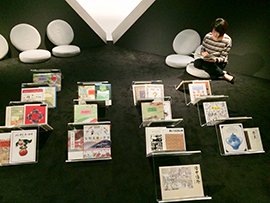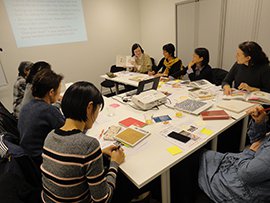The Work of the Japanese-Language Chief Advisor
The Japan Foundation, London
FUJIMITSU Yuko
Finding Activities that Take Advantage of the London Environment
London is famous worldwide as a city of art, and there are many exhibits introducing works by Japanese artists as well. Since being dispatched in London, one idea I have mulled over is to create opportunities for learning the Japanese language that make use of this favorable environment by moving back and forth between the classroom and the art world. And in the fall of 2019, I was fortunate to have the opportunity to realize that.
There is a gallery space within “Japan House London,” the facility in which the Japan Foundation, London (hereinafter “JF London”) is located. From late August through late October 2019, the gallery hosted a very popular exhibit called “The World of Anno Mitsumasa,” featuring the original drawings of that famous illustrator who is an author of children’s books.
Accordingly, I took advantage of the opportunity to plan a workshop in support of teachers entitled “Workshop to Examine Artworks as a Resource for Classroom Activities.” The response when we advertised for participants on the JF London website far exceeded expectations, with inquiries from even outside the UK, and we ultimately held the workshop a total of three times.

At the exhibit venue
Art and Active Learning
The key concept of the workshop is “art and active learning.” This involves exploring the potential of classroom activities that cultivate appreciation, observation, thinking, language skills, and creativity through dialogue while enjoying the world of art, with the ultimate aim of expanding the repertoire of classroom activities available to the teachers.
The day of the workshop begins with the participants gathering at the gallery. We then move to the seminar room where the participants introduce themselves and we enjoy some warmup activities to break the ice. Once the classroom atmosphere is relaxed, I have the participants experience participatory classroom activities in depth using children’s books. This is followed by a tea break exchange where we serve tea and snacks. The idea sharing and reflecting back on the activities will be in the second half of the workshop.
When conversation is based primarily on art, the participants begin to show their individual personalities with confidence. This allows them to encounter new points of view and unexpected interpretations. The same picture can be described in a variety of ways, and the memories the picture evokes is unique to each person’s life. Before long, the participants are telling each other their life stories, creating an opportunity for deep exchange.
The responses I received from participants after the workshop were extremely positive. Some of the feedback included that “the effort put into ensuring everyone can actively participate was greatly appreciated,” that “the smaller group allowing for deeper discussions was fun,” that “they were able to learn specific methods for using artworks as resources while also enjoying them,” and that “by experiencing the activities themselves, they will be able to understand how the learners feel.” These comments make it clear that the experience of enjoying participatory learning in a small group led to an understanding of the role of each activity and ideas for designing lessons.
There were even teachers who met via the workshop, found they got along well, and ultimately launched joint research projects together. In other words, a single workshop can become an opportunity to discover lifelong companions for learning.

A scene from the workshop
Workshops Create Synergy Between Participants
The participants at the workshop came from a variety of organizations. In addition to nine higher educational institutions in the UK, three higher educational institutions outside the UK and five secondary educational institutions in the UK, there were also participants from the Japanese Saturday Schools, early childhood educational institutes, and the International Children Bunko Association UK (ICBA UK), including not only teachers but illustrators of teaching materials as well, resulting in a highly diverse group.
While the common languages among the participants were English and Japanese, there were those whose native language was different than those as well. Generally speaking, the Japanese-Language Specialist is expected to create a menu of a series of activities according to the goal of the program, prepare those in multiple languages if possible, and then serve as the guide to explain and demonstrate the new concepts in a way that is easy to understand. It is also important to be able to flexibly make minor adjustments on the day depending on the participants to create a place where anyone can participate with confidence making use of their originality. And within that environment, the Japanese-Language Specialist must serve as the mediator to promote learning through dialogue.
One of my colleagues who supported the workshop noted that they were deeply fascinated how each workshop took on its own color, with the conversation taking different directions, because the synergy that emerged between that workshop’s participants created completely different reactions each time even though the activities were the same. The phrase “synergy between the participants” struck a chord with me. I realized that it was the main appeal of the workshop and one of the most important aspects of it.
When the individual personalities of each participant become resources themselves leading to a positive synergy between them, the result is a more enriching place for learning. My own work is driven by the desire to be involved in creating such a place.
- What We Do Top
- Arts and Cultural Exchange [Culture]
- Japanese-Language Education Overseas [Language]
- Japanese-Language Education Overseas [Language] Top
- Learn Japanese-language
- Teach Japanese-language
- Take Japanese-Language Test
- Know about Japanese-language education abroad
- The Japanese-Language Institute, Urawa
- The Japanese-Language Institute, Kansai
- Japanese-Language Programs for Foreign Specified Skilled Worker Candidates
- Japanese Language Education for Japanese Children Resident Overseas and for the Descendants of Migrants
- Archives
- Japanese Studies and Global Partnerships [Dialogue]
- JF digital collection
- Other Programs / Programs to Commemorate Exchange Year
- Awards and Prizes
- Publications
